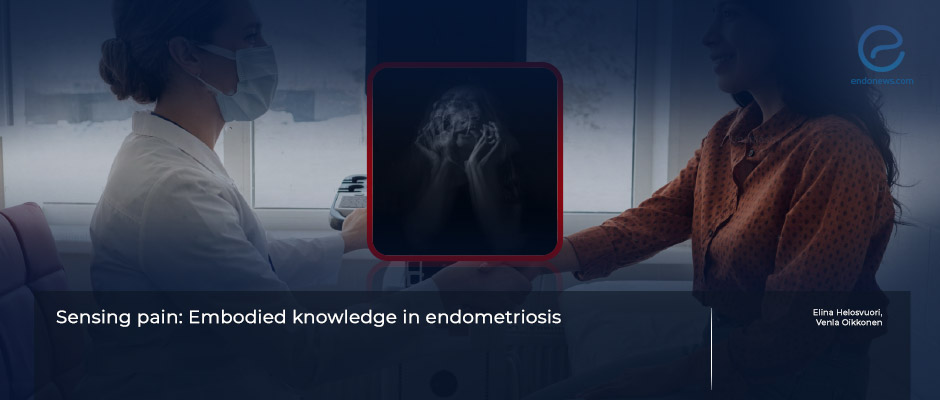Understanding endometriosis pain
Feb 23, 2024
Patients go through challenges when communicating endometriosis pain, study shows
Key Points
Highlight
- Understanding and addressing endometriosis pain requires considering both personal experiences and medical assessments.
- Healthcare professionals should acknowledge the complexity of pain and how it's felt by endometriosis patients.
Importance
- Integrating subjective experiences with medical assessments for effective pain treatment is important in management.
- There is a need for improvement of understanding and support in managing this condition.
What’s done here
- This interview-based study aimed to understand how individuals with endometriosis navigate and communicate their pain experiences.
- Semi-structured interviews performed between 2021 and 2023 were assessed and analyzed.
- Four key processes regarding pain embodiment and communication were identified.
Key results
- People with endometriosis develop a nuanced understanding of their pain over time.
- They can distinguish between different types of pain and assess symptom severity.
- Strategies for managing pain include pre-emptive medication and lifestyle adjustments, guided by medical advice and personal experiences.
- Patients often struggle to communicate pain nuances to clinicians and try to document their symptoms in detail.
- They feel misunderstood and neglected during medical encounters.
- Pain scales and imaging technologies used clinically may not fully capture the nuances of persistent pain, highlighting discrepancies between patients' experiences and medical assessments.
Lay Summary
Chronic pain, especially in conditions like endometriosis, poses significant challenges for diagnosis and treatment due to its multifaceted nature. Elina Helosvuori and Venla Oikkonen from Finland conducted a study in which they aimed to explore the complexities of chronic pain, particularly in the context of endometriosis, by analyzing how individuals with this condition develop embodied knowledge of their pain. They tried to understand how pain sensations are interpreted and communicated, shedding light on the discrepancies between patient experiences and medical understanding. They also aimed to improve diagnosis and treatment by advocating for a deeper acknowledgment of patient experiences in healthcare practices. The article was published in the December 2023 issue of the journal Health (London).
Semi-structured interviews with 26 Finnish individuals diagnosed with endometriosis between 2021 and 2023 were evaluated. Themes extracted from the interviews included descriptions of pain qualities, its role in disease experiences, and communication with healthcare providers. A joint analysis by the authors identified four key processes concerning pain embodiment and communication. These were 1) attuning to changes in pain, 2) distinguishing between benign and concerning pain, 3) preparing to communicate pain effectively, and 4) negotiating discrepancies between personal experiences and biomedical frameworks.
Attuning to changes in pain was crucial for those with endometriosis. The pain varied widely, from localized stabbing sensations to diffuse discomfort. This nuanced understanding, developed over the years, helped discern different pain types and assess symptom severity.
Learning to distinguish between harmless and dangerous pain was also crucial, especially considering the potential challenges in accessing medical care. Participants emphasized the importance of recognizing pain triggers and managing symptoms safely. Strategies included pre-emptive medication and lifestyle adjustments, guided by medical advice and personal experiences. While some pain was deemed manageable and non-threatening, the changes in pain patterns were monitored closely. Certain types of pain signaled potential disease progression.
Preparing to communicate pain presents a significant challenge for individuals with endometriosis seeking medical assistance. Studies reveal the struggle of conveying pain nuances to clinicians, with some resorting to detailed documentation of symptoms. Despite efforts, many feel misunderstood and neglected during medical encounters. Negotiating the discrepancies between experiences of pain and biomedical verification systems poses challenges in diagnosing and treating endometriosis. While pain scales and imaging technologies are used clinically, they may not fully capture the nuances of persistent pain. Patients' embodied experiences often diverge from medical assessments, influencing how pain is communicated and treated.
In conclusion, the authors say that understanding and addressing endometriosis pain requires considering both personal experiences and medical assessments. Doctors should acknowledge the complexity of pain and how it's felt by patients.
Research Source: https://pubmed.ncbi.nlm.nih.gov/38049994/
endometriosis pain communication chronic pain

